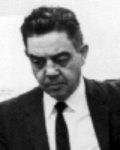
Home - Search - Browse - Alphabetic Index: 0- 1- 2- 3- 4- 5- 6- 7- 8- 9
A- B- C- D- E- F- G- H- I- J- K- L- M- N- O- P- Q- R- S- T- U- V- W- X- Y- Z
Ostrander, Don Richard
 Ostrander Credit: NASA |
Born: 1914. Died: 1972-10-26.
Don Richard Ostrander was a career Air Force officer who became a major general in 1958. He was deputy commander of the Advanced Research Projects Agency in 1959 and became director of NASA's launch vehicle programs in late 1959 as NASA began taking over responsibility for the Saturn program. He left NASA in 1961 and retired from the Air Force in 1965 as vice commander of the Ballistic Systems Division, Air Force Systems Command, to become vice president for planning of the Bell Aero Systems Corporation.
USAF Biography: MAJOR GENERAL DON R. OSTRANDER
Retired October 16,1965 Died October 26,1972 Major General Don Richard Ostrander is commander of the Office of Aerospace Research which is responsible for planning, programming and managing the U.S. Air Force research program.
General Ostrander was born in Stockbridge, Mich., attended local schools and studied engineering at Western State College; Mich. He entered the U.S. Military Academy at West Point in June 1933 and graduated in 1937.
From April 1938 until December 1939 he served as a troop commander in the cavalry at Fort Bliss, Texas. In 1939 he was detailed to the Ordnance Department and served in various positions in the Aviation Ordnance Field at Langley Field, Va., Baer Field, Ind., Selfridge Field, Mich., Florence, S.C. and Charleston, S.C. In May 1942 he was transferred to England where he became the ordnance and armament officer, Eighth Air Force Interceptor Command. During this tour General Ostrander helped modify the P-38 airplane to accommodate a bombardier with the Norden bombsight. He served as bombardier on the initial test missions of this aircraft over Europe.
In July 1944 the general returned to the United States and was assigned to Headquarters AAFTAC, Orlando, Fla., as chief, Auto and Munitions Branch and later served as director of materiel and services.
General Ostrander attended the Command and General Staff School at Fort Leavenworth, Kan., from March 1946 until graduation in July 1946, and then attended the Industrial College of the Armed Forces in Washington, graduating in June 1947.
This was followed by a four-year tour at Wright-Patterson Air Force Base, Ohio where the general served as chief, Fire Control Branch, Armament Laboratory and Chief of Plans, Engineering Division, Air Materiel Command.
From June 1951 until September 1954 General Ostrander served at Holloman Air Force Base, N.M., as deputy commander, 6540th Missile Test Wing. Later when Holloman was redesignated the Holloman Air Development Center, he became commander of this center.
General Ostrander's next assignment was as director of development at Headquarters Air Research and Development Command, Baltimore, Md., and in September 1955 he was designated assistant deputy commander for weapon systems, Headquarters ARDC, which moved to Andrews Air Force Base, Washington, D.C. In May 1957 he became deputy commander for resources, Headquarters ARDC, a position he held until August 1958.
The general was then appointed assistant for guided missiles production with the NATO International Staff, Paris, France and in October 1959 returned to the United States as deputy director of Advanced Research Projects Agency, Office of the Secretary of Defense, located in the Pentagon.
From October 1959 until August 1961 General Ostrander was director of the Office of Launch Vehicles, National Aeronautics and Space Administration, Washington and in September 1961 became vice commander, Ballistic Systems Division, Air Force Systems Command, Los Angeles, Calif.
In October 1962 General Ostrander assumed command of the Office of Aerospace Research in Washington, D.C.
Military decorations awarded General Ostrander include the Legion of Merit with two oak leaf clusters.
Country: USA. Agency: USAF. Bibliography: 535.
1972 October 26 - .
- Death of Don Richard Ostrander. - .
Related Persons: Ostrander.
American USAF officer, director of NASA launch vehicle programs and Saturn project, 1959-1961; vice commander USAF BMD 1961-1965. He left NASA after von Braun threatened to resign over Ostrander's demands that unproven USAF-developed Centaur electronics be used in the Saturn I booster in place of those designed by Walter Haeusserman of the von Braun team.
Back to top of page
Home - Search - Browse - Alphabetic Index: 0- 1- 2- 3- 4- 5- 6- 7- 8- 9
A- B- C- D- E- F- G- H- I- J- K- L- M- N- O- P- Q- R- S- T- U- V- W- X- Y- Z
© 1997-2019 Mark Wade - Contact
© / Conditions for Use